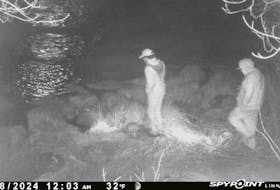The Mi’kmaw Conservation Group, in conjunction with the Department of Fisheries and Oceans, has been monitoring the fish in the river thanks to a smolt wheel.
“We always hope for a lot of salmon – it means they’re having a good year,” said Sana Kavanagh, a research and education officer with the conservation group, who was at the wheel Thursday morning.
“It’s important to monitor them because they are an endangered species. With the wheel, we can count how many Atlantic salmon smolt are leaving the river, and it allows us an estimation of the population for that life stage.”
The wheel was assembled at the Stewiacke River site, just off the Stewiacke River Park Road, on May 5 with the help of members from the Cobequid Salmon Association. The conservation group has been monitoring it five days a week since early May.
“We try to position the wheel in the main current, and there are little sides that divert more of the current into the wheel. The movement turns the wheel and the fish are lifted through it,” said Kavanagh.
The wheel has a catchment basin at the back of it, which is checked on a regular basis.
“We have to get the wheel in the water before the fish are running so we can get a clearer picture,” the officer said.
Salmon that are caught with the wheel have their measurements taken – length and weight, along with both a scale and tissue sample, which help identify age and genetics, respectively.
“The length and weight give us a sense of their health, and whether they’re small or large,” she said.
Along with the salmon, the conservation group also monitors American eels and their size and weight.
Whatever else is caught with the wheel is also documented, but only for species. So far this season, they have identified brown bullhead, brown trout, white suckers, shad, gaspereau, sticklebacks and shiners, as well as a number of frogs and salamanders.
“It really is a diverse assortment of fish,” said Kavanagh. “It’s really interesting to see what else is running in the river.”
Charlie Marshall is the conservation group’s summer student for the fourth consecutive year and is assisting Kavanagh on the wheel.
“It’s exciting every day,” he said. “There’s always something different. And early on, there were a lot of people that were stopping by to see what we were doing.”
Kavanagh says it’s great local people are finding an interest in the research, and one of the conditions the landowner included was to learn the results.
“People need to know that it’s dangerous to be around the trap, but we will always answer questions they have and always show them the fish,” added Kavanagh.
She said the wheel will continue for about another two weeks, but it depends on how many salmon are gathered daily.
“We had 12 on Monday, nine on Tuesday, one Wednesday and none (Thursday),” said Marshall. “It looks like it’s slowing down.”
Looking at last year’s numbers, Kavanagh said things have improved.
“Last year, they caught 75 smolts, and to date this year, we’ve caught 201,” she said, adding their biggest day saw 52 salmon in the wheel.
“That makes us very excited.”
Twitter: @TDNRaissa
AT A GLANCE
- Atlantic salmon (inner Bay of Fundy) spawning grounds used to encompass more than 40 rivers and streams in Nova Scotia and New Brunswick.
- Populations have declined by 90 per cent or more in recent years.
- The spawn in fresh water, but spend most of their life at sea.
- Atlantic salmon have pointed heads, well-developed teeth and silvery sides.
- When at sea, the salmon’s back varies in colour – shades of brown, green and blue with numerous black spots scattering its body.
- When spawning, salmon become bronze-purple in colour, developing reddish spots on its head and body.
- Salmon runs totalled 30,000 to 40,000 in the mid-1980s, and declined to less than 500 in 1998; in 2008, salmon runs declined below 200.
- Evidence suggests the decline in numbers is due to low marine survival, which reasons are unknown; it may be due to ecological changes within the Bay of Fundy.
Source: Department of Fisheries and Oceans website
The Mi’kmaw Conservation Group, in conjunction with the Department of Fisheries and Oceans, has been monitoring the fish in the river thanks to a smolt wheel.
“We always hope for a lot of salmon – it means they’re having a good year,” said Sana Kavanagh, a research and education officer with the conservation group, who was at the wheel Thursday morning.
“It’s important to monitor them because they are an endangered species. With the wheel, we can count how many Atlantic salmon smolt are leaving the river, and it allows us an estimation of the population for that life stage.”
The wheel was assembled at the Stewiacke River site, just off the Stewiacke River Park Road, on May 5 with the help of members from the Cobequid Salmon Association. The conservation group has been monitoring it five days a week since early May.
“We try to position the wheel in the main current, and there are little sides that divert more of the current into the wheel. The movement turns the wheel and the fish are lifted through it,” said Kavanagh.
The wheel has a catchment basin at the back of it, which is checked on a regular basis.
“We have to get the wheel in the water before the fish are running so we can get a clearer picture,” the officer said.
Salmon that are caught with the wheel have their measurements taken – length and weight, along with both a scale and tissue sample, which help identify age and genetics, respectively.
“The length and weight give us a sense of their health, and whether they’re small or large,” she said.
Along with the salmon, the conservation group also monitors American eels and their size and weight.
Whatever else is caught with the wheel is also documented, but only for species. So far this season, they have identified brown bullhead, brown trout, white suckers, shad, gaspereau, sticklebacks and shiners, as well as a number of frogs and salamanders.
“It really is a diverse assortment of fish,” said Kavanagh. “It’s really interesting to see what else is running in the river.”
Charlie Marshall is the conservation group’s summer student for the fourth consecutive year and is assisting Kavanagh on the wheel.
“It’s exciting every day,” he said. “There’s always something different. And early on, there were a lot of people that were stopping by to see what we were doing.”
Kavanagh says it’s great local people are finding an interest in the research, and one of the conditions the landowner included was to learn the results.
“People need to know that it’s dangerous to be around the trap, but we will always answer questions they have and always show them the fish,” added Kavanagh.
She said the wheel will continue for about another two weeks, but it depends on how many salmon are gathered daily.
“We had 12 on Monday, nine on Tuesday, one Wednesday and none (Thursday),” said Marshall. “It looks like it’s slowing down.”
Looking at last year’s numbers, Kavanagh said things have improved.
“Last year, they caught 75 smolts, and to date this year, we’ve caught 201,” she said, adding their biggest day saw 52 salmon in the wheel.
“That makes us very excited.”
Twitter: @TDNRaissa
AT A GLANCE
- Atlantic salmon (inner Bay of Fundy) spawning grounds used to encompass more than 40 rivers and streams in Nova Scotia and New Brunswick.
- Populations have declined by 90 per cent or more in recent years.
- The spawn in fresh water, but spend most of their life at sea.
- Atlantic salmon have pointed heads, well-developed teeth and silvery sides.
- When at sea, the salmon’s back varies in colour – shades of brown, green and blue with numerous black spots scattering its body.
- When spawning, salmon become bronze-purple in colour, developing reddish spots on its head and body.
- Salmon runs totalled 30,000 to 40,000 in the mid-1980s, and declined to less than 500 in 1998; in 2008, salmon runs declined below 200.
- Evidence suggests the decline in numbers is due to low marine survival, which reasons are unknown; it may be due to ecological changes within the Bay of Fundy.
Source: Department of Fisheries and Oceans website








